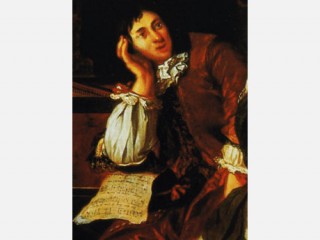
Dietrich Buxtehude biography
Date of birth : -
Date of death : -
Birthplace : Helsingborg, Skåne, Denmark
Nationality : Danish
Category : Historian personalities
Last modified : 2011-02-22
Credited as : Organist and composer, Baroque period,
The organ works and sacred vocal compositions of the Danish composer Dietrich Buxtehude (1637-1707) are the culmination of the North German school of composition in the 17th century.
Dietrich Buxtehude was born in either Holstein or Sweden (both were Danish territories at the time), the son of an organist. The family was of German extraction, and branches were located in various parts of Scandinavia, which had close cultural ties with Germany at the time. Buxtehude thus was exposed to the forms and styles typical of North German music.
Little is known of Buxtehude's early life, but he apparently received musical instruction from his father. He accepted positions as organist in 1657 at Helsingborg and in 1660 at Helsingur. On April 11, 1668, he succeeded the illustrious Franz Tunder to the prestigious post of organist at St. Mary's Church in Lubeck (marrying Tunder's daughter as one of the terms of succession) and remained in this post for the rest of his career.
Buxtehude was a truly inventive and imaginative composer in an era often marked by solid, workmanlike technique devoid of any profound inspiration. His extant works represent but a small portion of his production, and many of them exist only in secondary sources. Dating his work is close to impossible on any but stylistic grounds, and his flamboyant imagination led to a wide variety of stylistic treatment. Italian and South German music was known in his area, broadening the stock upon which he drew. With the growing emphasis of the time on individuality, he turned his back on authoritarian formulas and allowed his fiery imagination free rein.
Recent scholarship has shown that Buxtehude's sacred vocal works are, historically, his most important contribution, rather than the organ works as was previously thought. Few are liturgical. Most fall under the heading of cantata, if by this term one understands the earlier form as practiced by Tunder rather than the later genre represented by most of Johann Sebastian Bach's cantatas.
In 1673 Buxtehude established the famous Abendmusiken, or evening musicals, in St. Mary's; they took place from 4 to 5 P.M. on the five Sundays before Christmas. These performances included organ music as well as sacred works of a dramatic-allegorical nature for chorus, soloists, and orchestra; the bulk of the latter has disappeared.
Most of Buxtehude's 124 extant cantatas were probably written between 1676 and 1687. The solo portions exhibit operatic styles ranging from recitative to arias. There are also songlike pieces on lyric texts. Especially notable among the choral sections are the closing portions with closely imitative introductions, followed by fugal Alleluia or Amen sections. Throughout there is the strongest possible expression of the text content, achieved through the free exercise of musical fantasy. Buxtehude also wrote works based on melodies and texts of chorales (the traditional hymnody of Lutheranism), in some of which the melody is varied in each movement.
This wealth of expression made a profound impression on the young Johann Sebastian Bach, who in 1705 journeyed 200 miles on foot to hear Buxtehude's music and remained for 4 months. Thereafter Bach seems to have been determined to employ this expressive potential in church works.
Equally impressive for Bach must have been Buxtehude's organ music. Certainly the older composer comes closer than anyone else to Bach in the composition of the small-scale, subjective-interpretive chorale prelude (a free organ composition based on the melody of a Lutheran chorale, originally used to introduce congregational singing). This was a more southerly form. Buxtehude brought to its most advanced state the North German chorale fantasia, in which the chorale melody is so freely treated in a series of rhapsodic sections as to nearly disappear. For the most part his toccatas are in the then standard form, consisting of a sequence of diverse sections, including free fantasy, virtuoso pedal solos, and at least two fugues. Here, especially, his penchant for the daring and the unexpected comes strongly to the fore. There is also service music: Magnificats and Te Deums that could substitute for vocal performance and canzonas that were played during church services.
Undoubtedly a great deal of Buxtehude's keyboard and chamber music has been lost. The sonatas of 1696 cannot be his earliest attempts. His sonatas are somewhat retrospective, compared to the already-existing model of Arcangelo Corelli, and Buxtehude's keyboard suites follow the model of Johann Jakob Froberger. It is in the specifically North German forms that Buxtehude dominates and represents the climax of his era.
















